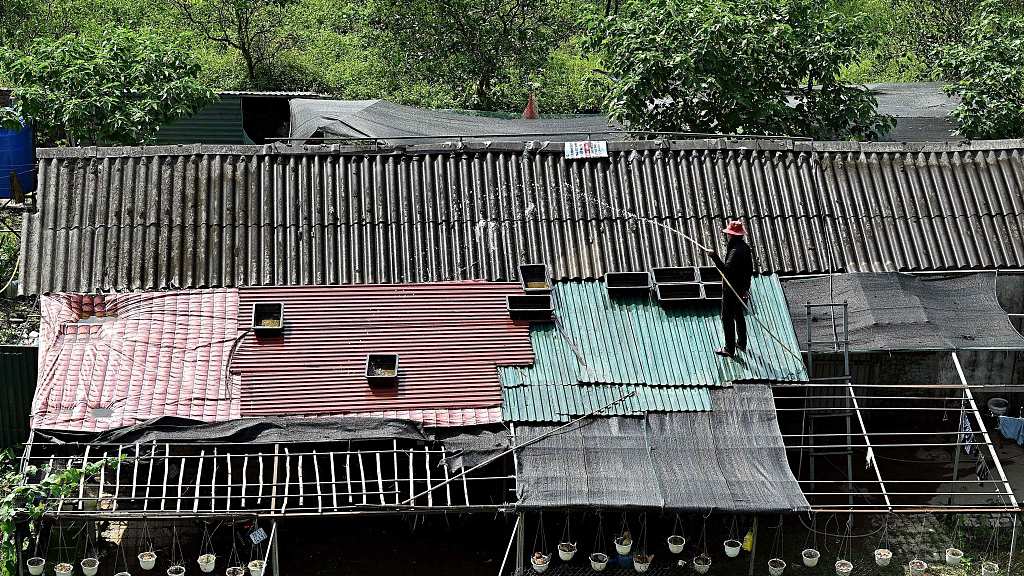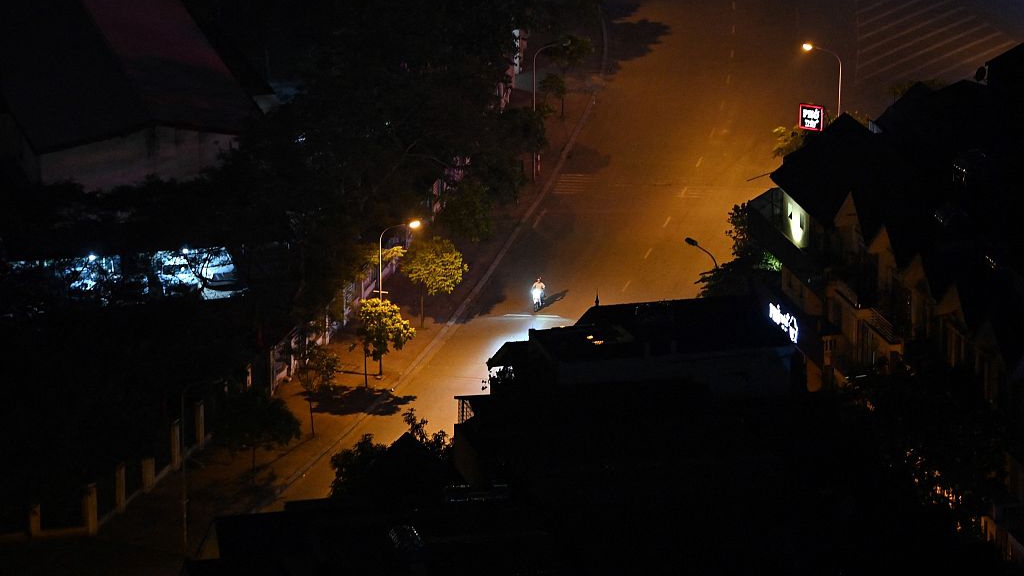
A view of Hanoi, Vietnam as some street lights were turned off to save electricity, May 30, 2023. /CFP
A view of Hanoi, Vietnam as some street lights were turned off to save electricity, May 30, 2023. /CFP
"We had a 26-hour power cut. It cost us tens of thousands of dollars that day. It's not nice at all," said Vu Chi Hieu.
Hieu is the director of Vietnam's KingBill XNK Joint Stock Company. His company produces aluminium parts in the Hanoi-neighboring province of Bac Ninh.
Such cases have been widely seen since early May this year when the Southeast Asian nation has struggled with record-shattering temperatures, which has led to a surge in power demand with dried hydropower reservoirs due to low rainfalls.

A woman watering her rooftop to cool down the heat in Hanoi, Vietnam. /CFP
A woman watering her rooftop to cool down the heat in Hanoi, Vietnam. /CFP
Southeast Asia usually experiences its hottest months of the year in April and May. This year, however, most countries in the region have been hit by unprecedented heat waves.
Thailand experienced its hottest day on record on April 15, when the temperature topped out at 45.4 degrees Celsius, and Laos reached 43.5 degrees Celsius for two consecutive days in May. In Vietnam, the temperature soared to 43.8 degrees Celsius on the first day of June, setting a new record for the same period.
A report from the World Weather Attribution described the April heat wave as "once in 200 years," which would have be "virtually impossible" without climate change.
Strained power supplies
The impact of power shortage has been more obvious in the northern provinces in Vietnam, where industrial parks abound.
The country's northern provinces of Bac Ninh and Bac Giang are key manufacturing areas for electronic components, where large multinational companies such as Samsung, Foxconn and Canon have set up factories.
Large capacity machines are usually used in their production, resulting in great demand for electricity.
However, the government's rolling power cuts have hit the area, making the manufacturing factories suspend their operations repeatedly.
According to a report by the state-run Vietnam Electricity Corporation, also known as EVN, the country's northern region may lack 8,000 megawatts of electricity, much higher than the previous forecast of 5,000 megawatts.
The direct damage from one single power outage affecting five manufacturers at an industrial park was over $190,000, Susumu Yoshida from Japan Chamber of Commerce and Industry told AFP.
"Total damage among industrial parks in northern Vietnam seems to be an unaccountable amount," he said.
Power shortage-plagues daily lives

A motorbike riding down a street in Hanoi, Vietnam as some street lights were turned off to save electricity, May 30, 2023. /CFP
A motorbike riding down a street in Hanoi, Vietnam as some street lights were turned off to save electricity, May 30, 2023. /CFP
"Because of the load shedding, some families and business people have to rent generators from me, and the order in my store has increased by 70 percent compared with the same period last year," the owner of a generator rental shop in Vietnam told China Media Group (CMG).
Using a private generator is quite "luxury" as it may cost about $50 a day, enough to cover a monthly electricity bill of a family of six, reported CMG.
The government also called on households to save energy with measures such as setting air conditioners' temperature above 26 degree Celsius while not using too many large electric appliances at the same time. Office buildings and shopping malls were encouraged to use just half of their advertising lighting.
Some local residents turned to a waterpark to cool off, in spite of risks of dehydration and exhaustion.
"The water can help overcome the heat, as there are no other immediate solutions," a 48-year-old resident told Reuters.
Neighboring support
Vietnam relies heavily on coal and hydropower for electricity generation.
However, a lack of rain has hampered its hydropower output as some of the country's northern provinces received "just about a fifth of last year's figure," and water levels at almost all northern hydropower plants "are too low for them to run at more than a quarter of designed capacity," Reuters reported, citing local data.
"Coal reserves in the country are also relatively low, and coal firms are not ready to churn out more in a very responsive way," reported Global Times, citing a businessman who asked to remain anonymous.
When the country suffered from a power crunch, Vietnam received support from China, which resumed the cross-border electricity exports to it for the first time since 2016.
In May, the two countries inked a sales deal to transfer electricity via 110-kilowatt power lines from Dongxing City in south China's Guangxi Zhuang Autonomous Region to Mong Cai in Vietnam.
According to the agreement, the channel is expected to supply 30 million kWh of electricity per month to Vietnam starting from May. Nearly 68 million kWh of electricity will be transmitted in the first stage, helping to ensure a green and stable power supply for the economic and social development of northern Vietnam.
The two countries initiated power grid connectivity in 2004 via five channels in Guangxi and southwest China's Yunnan Province, with the latter exports about 2 billion kWh of electricity to Vietnam per year, according to the Belt and Road Portal website.
Vietnam is also planning to increase power imports from Laos through the Nam Kong and Nam San hydropower plant clusters.
Also in May this year, the government approved a plan, known as PDP8, which requires $134.7 billion of funding to develop new power plants and grids by 2030, when half of office buildings and homes in Vietnam would be powered by rooftop solar panels and the country would be able to generate 5-10 gigawatts green energy for exports.